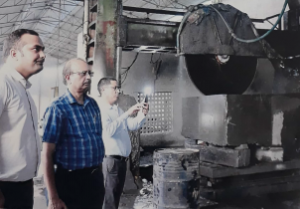Khammam factories construct recharge pits within their premises

From 16th -31st July, 2019, a team of central government officers visited the most water stressed villages of Khammam district in Telangana, namely Gurralapadu, Arempula, and Kondapuram (Khammam Rural Mandal), Mallemadugu village (Khammam Urban) and Pindiprolu (Tirumalayapalem) to assess their water conservation measures.
The team comprised Central Nodal Officer (CNO) – Sri Rajiv Ranjan Misra, DG NMCG; Sri Vijaya Prakash (BNO), Sri Ravinath Singh (TO), as a part of the Jal Shakti Abhiyan (JSA).

Water situation: The important rivers that flow through the district are – Munneru, Paleru, Akeru, Wyra and Kattaleru. Given that the central and western parts of the district are hilly with granite deposits that have little porosity and permeability owing to which rainwater fails to percolate into the deeper beds. As a result, groundwater storage is very minimal.
For JSA, the over exploited mandals in terms of ground water have been selected – Khammam Rural, Khammam Urban (Raghunathapalem), Tirumalayapalem and Kusumanchi Mandals, so that the water situation can be improved through construction of rain water harvesting (RWH) recharge pits and other water conservation structures.


Accompanied by the District Collector, Mr. R V Karnan, the JSA team visited some of the granite cutting and polishing units situated in the villages of Gurralapadu, Arempula and Kondapuram in Khammam rural; Mallemadugu village in Khammam Urban and Pindiprolu village in Tirumalayapalem. There they interacted with factory owners to understand water usage in their units in the process of cutting and polishing granite. The unit holders informed that owning to unavailability of ground water, most of the factories purchase water from tankers. However, they pointed out that they had already constructed grey water recycling compartments for treating grey water which can then be used in their factories for cutting and polishing granite.
JSA team stressed upon the need to construct RWH recharge pits to conserve water and improve groundwater levels within the factory premises. They stressed upon the need to build structures to suit local conditions. In this regard, the DC issued a circular to all stakeholders of the water-stressed mandals to construct such pits in their premises – at their own cost.


Meanwhile, the Assistant Director of Mines and Geology conducted a series of meetings with stakeholders including Granite Factory Owners Association and Ground Water Department to motivate people to build recharge pits to improve ground water levels.
In addition, they asked the district team to:
• mobilize local NGOs, industrialists and other volunteers to undertake conservation works
• undertake geo-morphology based site identification for effective recharge pits
• making inventory of existing structures and restoring them through renovation and maintenance to improve efficiency and effectiveness
• encourage water conservation by constructing RWH structures within premises of granite cutting and polishing units
Stakeholders have been convinced to start construction of the same, as per the norms stipulated by the Ground Water Department: Once a pit is dug, 50% should be filled with 40MM rough stones. On top of that, 25% of the pit should be filled with 20MM stones. Thereafter, the next 15% should be covered with coarse sand, leaving the balance 10% open. A compound wall measuring one foot in height should be constructed around the pit, leaving small gaps on four sides so that rainwater can pass through them into the conservation pit.


During the month of July, as many as 26 RWH pits have been constructed within the premises of granite factories. It was a good example of convergence of industry and district administration. Over the next fortnight, additional 55 RWH pits will be constructed as per the guidelines of JSA.
Further as suggested by JSA, water logged quarries are supplying their seepage water to adjacent agricultural lands and for the development of plantations around the quarries.
[ The Blog was first published on https://jalshakti.wordpress.com/]





